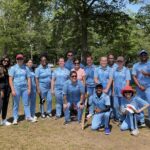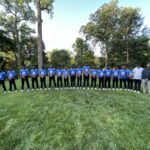In an important step for disability inclusion and public health, the National India Hub (NIH) in Schaumburg, Illinois, launched a specialized Bystander Cardiopulmonary Resuscitation (CPR) Training Program for the visually impaired on September 15, 2025.
This initiative addresses a critical gap in emergency preparedness, as accessible CPR training for individuals with disabilities remains rare worldwide. By pioneering this program, NIH not only leads the way in Illinois but also offers a replicable model to empower visually impaired community members with life-saving skills, according to a statement.
The driving force behind the program is Dr. Vemuri S. Murthy, a renowned Indo-US resuscitation expert with a career spanning clinical medicine, academic leadership, and community health advocacy. Dr. Murthy founded the NIH Community Health and CPR Training Center in 2024 and spearheaded Project SMILE (Saving More Illinois Lives through Education) under the Chicago Medical Society. He also serves as Adjunct Associate Professor in Emergency Medicine (Global Health) at the University of Illinois College of Medicine.
Designed specifically for visually impaired learners, the training incorporated the latest international guidelines and advanced manikin technology. Participants practiced hands-on CPR using tactile models, auditory cues, and real-time feedback. A “Training Buddy System” paired each visually impaired attendee with a sighted partner, ensuring safety, guidance, and personalized coaching.
Adding an international dimension, the Samarthanam Trust India’s music ensemble, featuring the visually impaired Samarthanam Sisters, Anusha and Vasundhara, along with their orchestra, attended the session. Their presence highlighted the universal importance of inclusive health education and the potential to expand similar initiatives to visually impaired communities in India.
The ninety-minute session, led by Dr. Murthy along with NIH instructors Smita Shah and Saloni Shah, covered “Hands-only” CPR and the use of Automated External Defibrillators (AEDs). Tactile models helped participants feel correct hand placement and compression depth, while audio instructions reinforced proper techniques, the statement added.
Dr. Murthy evaluated participants using structured feedback and noted that their CPR performance matched that of sighted individuals. He emphasized that the training not only challenges misconceptions about disability but also demonstrates the effectiveness of inclusive teaching strategies.
At the conclusion, participants received official Bystander CPR certificates from the NIH Training Center. Harish Kolasani, Founder of NIH, joined Dr. Murthy in recognizing the Samarthanam Sisters, their team, and Shruti Shree Tyagi, Overseas Relations Lead for Samarthanam Trust, for their contributions.
In a post-event interview, Dr. Murthy stressed the importance of customized CPR programs for people with disabilities, noting that organizations such as the American Heart Association and American Red Cross already advocate for adapted instruction. He highlighted innovations from the Blind Muse Foundation in tactile and audio-based CPR and called for wider use of accessible resources such as Braille, large-print materials, buddy systems, and AEDs with audible prompts.
Looking ahead, Dr. Murthy envisions a future where affordable, AI-driven devices enhance CPR accessibility for the visually impaired. The NIH program, he said, sets a precedent for inclusive emergency preparedness, showing how thoughtful adaptation and collaboration can break down barriers and save lives.






